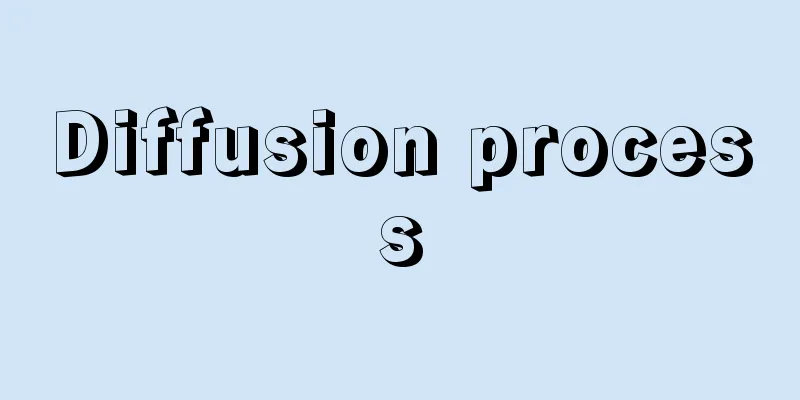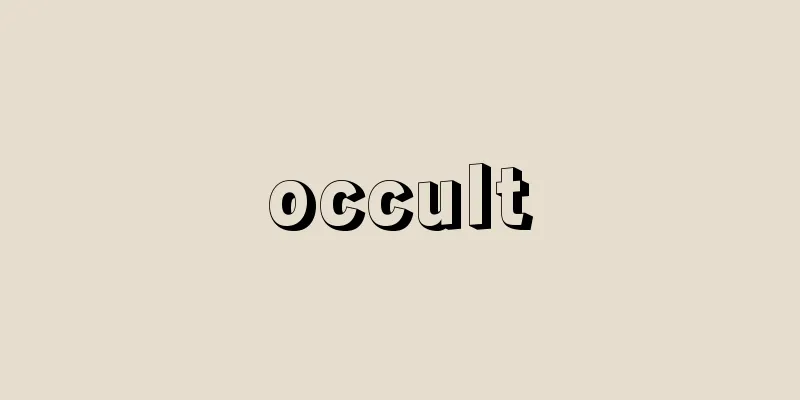Causal relationship

|
It refers to the relationship of cause and effect between one fact and another, in other words, the relationship in which one fact causes another. The concept of causation is also discussed in the fields of science and philosophy, but in law, causation plays an extremely important role in objectively limiting the scope of legal responsibility, especially criminal and civil liability. In other words, in order to hold an actor legally responsible for a certain result, it is necessary that there be a causal relationship between the act and the result, and if this is not recognized, it is merely an act of unavoidable force and legal responsibility cannot be held. [Tetsuro Nawa] lawRegarding how legal causation should be understood, there has been a major conflict between the condition theory and the appropriateness theory (or appropriate causation theory). According to the condition theory, legal causation is understood to be sufficient if there is a conditional relationship (conditio sine qua non) between an act and a result, i.e., "If A had not occurred, B would not have occurred." According to this view, anything that constitutes some natural condition for a result has a causal relationship. For example, the mother of a murderer has a causal relationship with the murderer. This broadens the scope of causation too much. Therefore, from the standpoint of trying to limit causation in the condition theory, the appropriateness theory assumes the existence of a conditional relationship in the condition theory, and from this, it is only when it is deemed appropriate that the result should result from the act in light of general empirical rules that legal causation is recognized. However, there are three theories on what circumstances (materials) should be used to determine appropriateness in the appropriateness theory: That is, there are three theories: the subjective theory, which is based on the circumstances that the perpetrator was actually aware of or could have been aware of at the time of the act; the objective theory, which is based on the circumstances that existed objectively at the time of the act as well as circumstances that existed after the act, including those that were foreseeable; and the compromise theory, which is based on the circumstances that the average person could have recognized at the time of the act and the circumstances that the perpetrator was actually aware of. Of the above theories, the eclectic theory of appropriateness has traditionally been the prevailing academic position. In fact, the theory of appropriateness has been adopted in civil cases. However, in criminal cases, the Great Court and the former Supreme Court have basically adopted the condition theory (although there are many lower courts that adopt the theory of appropriateness). Since the Supreme Court's decision on a hit-and-run case involving a U.S. soldier in 1967 (Showa 42) used language reminiscent of the theory of appropriateness, there was widespread speculation that criminal cases would also shift to the theory of appropriateness. However, the Supreme Court has made it clear that it will not adopt the eclectic theory of appropriateness, and has adopted its own view, focusing on the "danger of the act" (the act itself has the risk of causing a criminal outcome) in the act of execution. According to this view, causation is "danger and its realization," that is, the question of whether the danger of the act can be said to have been realized in the result, and the greater the danger of the act, the more the causal relationship cannot be denied, even if special circumstances that intervene after the act hastened the occurrence of the result. This view of the Supreme Court shows a method of judgment based on empirical rules from the standpoint of the corresponding theory, and is not interpreted as contradictory to the corresponding theory itself. Furthermore, triggered by the postwar pollution incidents, a new view has emerged that in cases where the scientific mechanism has not been elucidated, it is sufficient to introduce "epidemiological causation," that is, epidemiological statistical methods, and to recognize a certain degree of probability between an act and a result. While this theory of epidemiological causation is supported by many in civil cases, which aim to fairly distribute damages, it is also strongly criticized in criminal cases as going against the basic principle that "in case of doubt the benefit of the defendant should prevail." [Tetsuro Nawa] philosophyThis refers to the European cause and effect relationship, but the concept of cause and effect is widely used in daily life, so there is no need to explain it again. However, some philosophers impose restrictions on the use of this concept, so I will introduce them first. If you want to raise your right hand, it will usually rise, and if you are hungry, you will often feel irritated. In this way, it is generally considered natural that the state of the mind causes the movement of the body, and conversely, the state of the body causes a change in the state of the mind. However, in classical physics, the mind is not mentioned when describing the movement of objects, and the description is done using only concepts related to matter. This gives rise to the idea that the movement of the body, which is a type of object, is also completely material, and therefore it is wrong to recognize a causal relationship between the mind and the body. For philosophers who follow this idea, the problem arises of how to explain the correlation between the mind and the body given above without using the concept of causation. This is one of the origins of the mind-body problem. In natural sciences, the laws that govern change and motion are often given in the form of differential equations. In such cases, if the initial conditions are determined, the state at every time is often determined, so the initial conditions are sometimes called the cause and the state at the time of interest is called the result. However, this initial condition can also be for a future time, so the concepts of cause and effect in this case are slightly different from those in everyday life. In daily life, we often come to recognize a causal relationship between two events A and B after repeatedly observing that A occurs followed by B. However, it is well-known that such repetition does not necessarily mean that we can expect A to be followed by B in the future. For this reason, it is sometimes said that a causal relationship that seems established at present may be in danger of being broken by future experiences. The 18th century British philosopher Hume is particularly famous for pointing this out. Statistics accepts this point, replaces causal relationships with correlation, and then says that estimates of correlation are not always accurate, and aims to improve the accuracy of these estimates as much as possible. Thus, philosophical debates on causal relationships are taking place from various standpoints. [Yoshida Natsuhiko] Source: Shogakukan Encyclopedia Nipponica About Encyclopedia Nipponica Information | Legend |
|
ある事実と他の事実との間に原因と結果の関係、いいかえれば、ある事実から他の事実が引き起こされたという関係をいう。因果関係の概念は科学や哲学の領域でも論じられるが、法律上では、とくに刑事責任や民事責任など法的責任の範囲を客観的に限定するうえで、因果関係はきわめて重要な役割をもつ。すなわち、ある結果に対して行為者に法的責任を追及するためには、行為と結果との間に因果関係が存在することを要し、これが認められない場合には不可抗力にすぎないから法的責任を問いえない。 [名和鐵郎] 法律法律上の因果関係をどのように理解すべきかについては、従来から、大きく条件説と相当説(または相当因果関係説)との対立がある。条件説によれば、法律上の因果関係は、行為と結果との間に「AがなかったらBもなかったであろう」という条件関係conditio sine qua non(ラテン語)があれば足りるものと解される。この見解に従えば、結果に対してなんらかの自然的条件をなすものはすべて因果関係ありということになる。たとえば殺人犯の母親は、この犯人の殺人に対して因果関係があることになる。これでは因果関係の範囲があまりにも広がりすぎる。そこで、条件説における因果関係を限定しようとする立場から、条件説における条件関係の存在を前提としつつ、このなかから、一般経験則に照らして、その行為からその結果が発生することが相当であるとみられる場合にのみ、法律上の因果関係を認めようとするのが相当説である。ただ、相当説にも、その相当性をどのような事情(資料)を基礎として判断すべきかについて次のような3説がある。すなわち、行為当時に行為者が現に認識していた事情または認識しえた事情を基礎とする主観説、行為当時に客観的に存在していた事情および行為後の事情でも予見可能なものをも含めて基礎とする客観説、行為当時、一般人に認識しえた事情および行為者が現に認識していた事情を基礎とする折衷説がそれである。 以上の諸説のうち、学説上は、従来、折衷的相当説が通説的立場を占めていた。そして実際、民事判例においては相当説が採用されている。しかし、刑事判例では、大審院やかつての最高裁判所は基本的には条件説的立場によるものとされてきた(ただし下級審には相当説によるものも少なくない)。1967年(昭和42)の米兵ひき逃げ事件最高裁判決が相当説を思わせる表現を用いたこともあって、その後、刑事判例も相当説に移行するのではないかという観測が広がった。しかし、最高裁は折衷的相当説を採用しないことを明言したうえで、実行行為における「行為の危険」(行為が、それ自体として犯罪結果を発生させる危険性を有すること)に着目して独自の見解を採用するに至っている。この見解によれば、因果関係とは「危険とその実現」、すなわち、行為の危険が結果に現実化したといいうるかという問題であるから、行為の危険が大きければ大きいほど、かりに行為後に介在した特殊な事情によって結果発生が早まったとしても、因果関係は否定されないことになる。このような最高裁の見解は、相当説の立場から、経験則による判断方法を示したものであって、相当説自体と矛盾するものではないと解されている。 なお、戦後の公害事件を契機として、科学的なメカニズムが解明されていない事案に関して「疫学的因果関係」、すなわち、疫学上の統計的手法を導入して、行為と結果との間に一定の蓋然(がいぜん)性が認められれば足りるとする考え方がみられる。このような疫学的因果関係論については、損害の公平な分担を目的とする民事事件については支持する者も多いが、刑事事件に関しては「疑わしきは被告人の利益」という基本原則に反するとして批判も根強い。 [名和鐵郎] 哲学ヨーロッパ流の原因と結果の関係をいうが、原因・結果の概念は日常生活でもよく使われているものであり、改めて解説するには及ぶまい。ただし、哲学者のなかには、この概念の使い方に制限を付け加える者があるので、まずその点を紹介する。右手をあげようと思えば普通は右手があがるし、また空腹になればいらいらすることも多い。このように、精神の状態が原因となって身体の運動が結果し、また逆に身体の状態が原因となって精神の状態の変化が結果することは、普通はあたりまえのことと考えられている。しかし、古典物理学では、物体の運動を記述するときに精神に言及することはなく、すべて物質に関する概念だけを用いてこの記述を行う。ここから、物体の一種である身体の運動もまったく物質的なものであり、したがって心身の間に因果関係を認めるのは間違いだとする考えが生まれる。この考えを奉ずる哲学者にとっては、先ほど例にあげた心身の相関を、因果の概念を使わずに説明するには、どうしたらよいかという問題が生ずる。これが心身問題の一つの発端である。 よく、自然科学では、変化や運動を支配する法則を微分方程式の形で与える。このとき、初期条件が決まればすべての時刻における状態が決まることが多いので、初期条件を原因、注目している時刻における状態を結果ということがあるが、この初期条件は未来の時刻のものでもよいので、この際の原因・結果の概念は、日常生活のものとはすこしずれる。 さて、日常生活で、二つの事象A、Bの間に因果関係を認めるようになるのは、Aが生じたのちBが生ずるということが繰り返し観察されたのちであることが多い。しかし、このような繰り返しがあったからといって、将来もAに続いてBがおこると期待できるかといえば、かならずしもそうではないことは、よく経験されているところである。ここから、現在は確立されているようにみえる因果関係も、将来の経験によって破られるおそれがあるのではないかといわれることがある。とくに18世紀イギリスの哲学者ヒュームがこのことを指摘したので有名である。統計学は、この指摘を受け入れ、因果関係を相関関係に置き換えたうえで、相関関係の推定も絶対に正確ではないとし、さらにこの推定の精度をなるべく高めることを目ざしているといえる。このように、因果関係をめぐっては種々な立場から哲学的な議論が行われている。 [吉田夏彦] 出典 小学館 日本大百科全書(ニッポニカ)日本大百科全書(ニッポニカ)について 情報 | 凡例 |
>>: What goes around comes around
Recommend
Ihei Muraoka - Ihei Muraoka
Year of death: 1943 (Showa 18) Year of birth: Octo...
automatic train stop device
…It is an abbreviation of automatic train stop de...
Kiel Canal - Kiel Canal
An artificial waterway that crosses Schleswig-Hols...
Quintus Smyrnaeus
A 4th-century Greek poet. Author of a 14-volume he...
Kawai Movies - Kawai Movies
...Kokukatsu began film production at Sugamo Stud...
Grape - Grapes
A deciduous vine of the Vitaceae family. There are...
white pine
...The base of the scale leaves on the long branc...
Tadamasa Annaka
… [Takeo Arisue] [Annaka Castle Town] A castle to...
Ring peeling - Kanjohakuhi (English spelling) ringing
This is also called annular barking, and involves ...
Regional Administration - Koikigyosei
The establishment of wide-area administrative uni...
Raška (English spelling)
… 【history】 [Founding of the medieval Kingdom of ...
Yonashiro [town] - Yonashiro
This former town is located in Nakagami District, ...
Oleomargarine
Also called oleo oil. An oil obtained by squeezing...
Case - Vagina
A cover used to protect books. It is also called ...
Fado triste (English spelling)
…The word fado means “fate” or “destiny,” and the...









